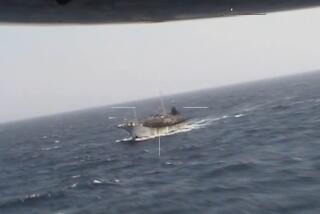FISH: Taxidermist Puts Life Back Into Trophies : Baja Taxidermist Has the Stuff to Prove Many a Fish Story
- Share via
ROSARITO — Mexico is full of surprises but nothing quite prepares visitors for the interior of an unobtrusive, cinder-block building here.
Inside the barracks-like structure, the curving forms of dozens of great fish--marlin, swordfish, tuna and a netful of other species--hang suspended from the rafters like sides of beef at a giant butcher shop. Workers carry the fish facsimiles about and work on them in a manner reminiscent of an auto-body shop.
“After a while it doesn’t seem so unusual,” said one worker, standing amid colleagues using paint and bonding compounds on the figures of a dozen giant fish.
The business, Pflueger Taxidermia de Mexico, is in fact a marine taxidermist--the “world’s largest,” according to a sign and the firm’s brochure, although the U.S. proprietor acknowledges that this is not the case. The firm mounts fish, mostly game fish caught off the Baja peninsula, for fishing enthusiasts worldwide. U.S. residents make up the bulk of the clientele.
“We’ve got customers in Germany, Switzerland, New Zealand . . . all over the place,” said Robert R. Mehrer, president of Pflueger.
Mehrer’s firm is one of the more unusual of the many businesses that flourish along the U.S.-Mexico border, a place where the lure of cheap labor, the tourism business and the proximity of two cultures and nations have attracted many disparate enterprises. In fact, the cash-short Mexican government has embarked on a program to attract a wide range of U.S. businesses, streamlining some of the red tape and bureaucratic delays that are legend south of the border--and well known to the Rosarito taxidermist.
“It took us 10 years to set up here,” said the bearded Mehrer.
The business came to Rosarito in 1979, attracted by inexpensive labor and the proximity of Mexican and Hawaiian game fish. Formerly associated with the well-known Pflueger Marine Taxidermy in Florida, the Rosarito operation has since separated from the mother firm. The Florida business was founded in 1926 by Al Pflueger Sr., who set up shop in his garage and began mounting fish. Mehrer, a former North Miami Beach police officer and longtime motorcycle enthusiast, learned the business from the elder Pflueger while moonlighting from police work.
“He (Pflueger) was the master,” Mehrer says. “Me, I love fish and I love Mexico.”
Each year, the Rosarito firm mounts 1,200 to 1,500 fish, according to Bruce Babb, the production manager. The price: $480 for species up to 150 pounds, and $2 for each pound thereafter. There is a minimum $99 charge for smaller fish. Some customers have paid up to $2,000 to have their favorite catch mounted.
Here one finds regal billfish such as the sailfish, swordfish and marlin, as well as distinctive species such as the rooster fish, named for its unique dorsal fin; the multicolored dorado and even the occasional shark and barracuda. The firm has mounted fish ranging from a 919-pound blue marlin to a three-inch bait fish now hanging in Mehrer’s office.
“No fish too large or too small,” is how company officials like to put it.
Why do people pay so much to stuff a fish?
David Plaza, an Orange County resident who was picking up two large mounted marlins for a friend, offered an explanation.
“He (the customer) is crazy about fishing,” said Plaza as he tried to stuff a large mounted marlin into his hatchback. “One’s for the office, the other’s for his house.”
The taxidermists work out of a rectangular, block-long building alongside the toll road between Tijuana and Ensenada. Inside, dozens of fish skins, molds and mounts hang from the aluminum roof and, on the floor, piles of dried fish skins, tails and heads sit in piles. The odor is redolent of fish, chemicals and paint.
The firm receives its skins from Cabo San Lucas and other Mexican fishing spots, where trophy fish are quickly skinned and the skin is treated with a temporary preserver. Throughout Mexico, Pflueger agents direct fishermen on how to get their prizes mounted.
“You catch it, we mount it,” says a Pflueger motto.
The fish skins are subjected to an elaborate mounting process by about 40 workers laboring in an assembly line. Because of the heavy demand and the amount of tedious work involved, it can take six months to mount a fish. The pay scale here--about $11 per day--is one-fifth of what similar workers would receive in the United States, Mehrer said.
All skins are chemically treated to remove excess material and oil that could later damage the mounted fish. Mehrer says he uses a “secret process” that he originally learned from the elder Pflueger but has since refined. Both before and after chemical treatment, workers use scalpels and other tools to remove excess tissue that could cause problems.
Pflueger officials say they are conscientious about remaining faithful to the form and shape of the original fish. They scoff at the so-called fish “replicas” made of pure fiberglass--totally devoid of fish skin--that are increasingly popular in the United States.
“The fish you caught is the fish you get,” says another company motto.
After treatment, the larger skins are attached to plaster molds designed to simulate the contours of the original fish. Heads and tails that have been treated separately must be matched to the original skins. Once attached to the molds, the mounted fish are ready for finishing--loose pieces are patched, fiberglass fins and crystal eyes and the fish are painted, perhaps the most crucial stage.
Clearly the star of Pflueger is Luis Martinez, the resident artist. Martinez, a former furniture and house painter from Mexicali, applies his spray paints to the fish with the pride of a Matisse.
“Please Do Not Disturb Artist While Painting,” reads a sign, printed in both English and Spanish.
Most fish have intricate color patterns. When they die, however, their skin quickly loses color. Most of the skins that arrive at Pflueger have a dull, charcoal-gray patina. Martinez’s job is to bring them back to their once regal state.
In his seven years at Pflueger’s, Martinez says he has learned the color schemes for the most common fish, such as marlin, sailfish and tuna. If an odd fish arrives, he uses photographs that are on file for guidance, but he says that the pictures never capture the true glory of the fish. Martinez, who was trained for two months by an artist brought in from Florida, is a fisherman himself and has made it a point to go to the Baja fishing spots and see the great fish.
“In this job, you’ve got to have imagination,” said Martinez, a 33-year-old father of four who lives in a simple house next to the taxidermy shop. “It’s a lot different than painting furniture.”
His creations attest to his skill. The painted fish are replete with bold strokes of iridescent blue and green.
“For me, this is a very gratifying job, very challenging,” Martinez said. “To get the coloring right, to satisfy a client, that is something that truly makes one feel good.”
More to Read
Sign up for Essential California
The most important California stories and recommendations in your inbox every morning.
You may occasionally receive promotional content from the Los Angeles Times.












